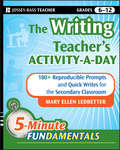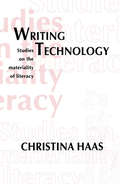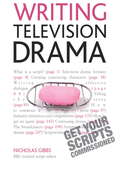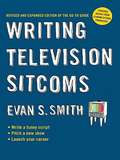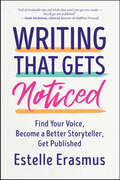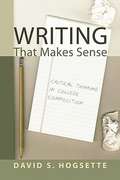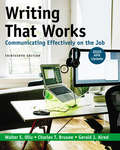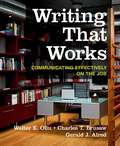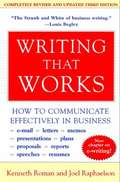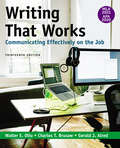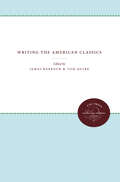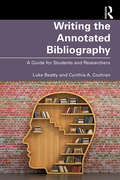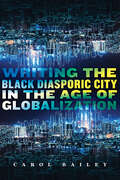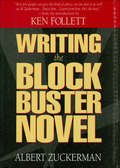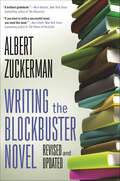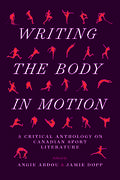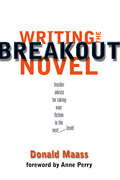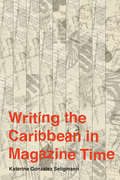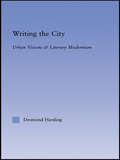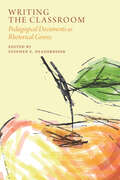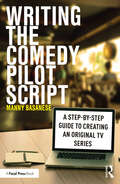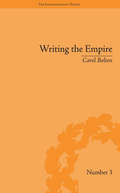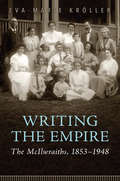- Table View
- List View
The Writing Teacher's Lesson-a-Day: 180 Reproducible Prompts and Quick-Writes for the Secondary Classroom (JB-Ed: 5 Minute FUNdamentals #3)
by Mary Ellen LedbetterClassroom-tested methods for boosting secondary students' writing skills The Writing Teacher's Activity-a-Day offers teachers, homeschoolers, and parents 180 ready-to-use, reproducible activities that enhance writing skills in secondary students. Based on Ledbetter's extensive experience consulting to language arts teachers and school districts across the country, the classroom-tested activities included in this book teach students key literary and writing terms like allegory, elaboration, irony, personification, propaganda, voice, and more--and provide them with engaging examples that serve as models for their own Quick Writes. Contains writing prompts and sample passages in student-friendly language that connects abstract literary concepts to students' own lives Written by popular workshop presenter and veteran educator Mary Ellen Ledbetter Offers a user-friendly, value-packed resource for teaching writing skills Designed for English language arts teachers in grades 6-12, tutors, parents, learning specialists, homeschoolers, and consultants.
Writing Technology: Studies on the Materiality of Literacy
by Christina HaasAcademic and practitioner journals in fields from electronics to business to language studies, as well as the popular press, have for over a decade been proclaiming the arrival of the "computer revolution" and making far-reaching claims about the impact of computers on modern western culture. Implicit in many arguments about the revolutionary power of computers is the assumption that communication, language, and words are intimately tied to culture -- that the computer's transformation of communication means a transformation, a revolutionizing, of culture. Moving from a vague sense that writing is profoundly different with different material and technological tools to an understanding of how such tools can and will change writing, writers, written forms, and writing's functions is not a simple matter. Further, the question of whether -- and how -- changes in individual writers' experiences with new technologies translate into large-scale, cultural "revolutions" remains unresolved. This book is about the relationship of writing to its technologies. It uses history, theory and empirical research to argue that the effects of computer technologies on literacy are complex, always incomplete, and far from unitary -- despite a great deal of popular and even scholarly discourse about the inevitability of the computer revolution. The author argues that just as computers impact on discourse, discourse itself impacts technology and explains how technology is used in educational settings and beyond. The opening chapters argue that the relationship between writing and the material world is both inextricable and profound. Through writing, the physical, time-and-space world of tools and artifacts is joined to the symbolic world of language. The materiality of writing is both the central fact of literacy and its central puzzle -- a puzzle the author calls "The Technology Question" -- that asks: What does it mean for language to become material? and What is the effect of writing and other material literacy technologies on human thinking and human culture? The author also argues for an interdisciplinary approach to the technology question and lays out some of the tenets and goals of technology studies and its approach to literacy. The central chapters examine the relationship between writing and technology systematically, and take up the challenge of accounting for how writing -- defined as both a cognitive process and a cultural practice -- is tied to the material technologies that support and constrain it. Haas uses a wealth of methodologies including interviews, examination of writers' physical interactions with texts, think-aloud protocols, rhetorical analysis of discourse about technology, quasi-experimental studies of reading and writing, participant-observer studies of technology development, feature analysis of computer systems, and discourse analysis of written artifacts. Taken as a whole, the results of these studies paint a rich picture of material technologies shaping the activity of writing and discourse, in turn, shaping the development and use of technology. The book concludes with a detailed look at the history of literacy technologies and a theoretical exploration of the relationship between material tools and mental activity. The author argues that seeing writing as an embodied practice -- a practice based in culture, in mind, and in body -- can help to answer the "technology question." Indeed, the notion of embodiment can provide a necessary corrective to accounts of writing that emphasize the cultural at the expense of the cognitive, or that focus on writing as only an act of mind. Questions of technology, always and inescapably return to the material, embodied reality of literate practice. Further, because technologies are at once tools for individual use and culturally-constructed systems, the study of technology can provide a fertile site in which to examine the larger issue of the relationship of culture and cognition.
Writing Television Drama: Teach Yourself
by Nicholas GibbsBreak Into Writing For Television takes you from the very first line of the script through to becoming a regular writer for soaps and 'continuing dramas'. It starts with the basics of different types of script and production, and moves on to getting ideas, shaping character and dialogue, re-writing, pitching work and the practicalities of who does what in the production world, in both the UK and the US. Structured around a practical, progressive, goal-orientated approach, each chapter contains a diagnostic test, case studies, practical exercises and Aide Memoire boxes. Each chapter concludes with a reminder of the key points of the chapter (Focus Points) and a round-up of what to expect in the next (Next Step), which will whet your appetite for what's coming and how it relates to what you've just read.
Writing Television Drama: Get Your Scripts Commissioned
by Nicholas GibbsBreak Into Writing For Television takes you from the very first line of the script through to becoming a regular writer for soaps and 'continuing dramas'. It starts with the basics of different types of script and production, and moves on to getting ideas, shaping character and dialogue, re-writing, pitching work and the practicalities of who does what in the production world, in both the UK and the US. Structured around a practical, progressive, goal-orientated approach, each chapter contains a diagnostic test, case studies, practical exercises and Aide Memoire boxes. Each chapter concludes with a reminder of the key points of the chapter (Focus Points) and a round-up of what to expect in the next (Next Step), which will whet your appetite for what's coming and how it relates to what you've just read.
Writing Television Sitcoms (revised)
by Evan S. SmithNew edition of the popular screenwriting guide! Writing Television Sitcoms is the ultimate all-in-one guide to writing a funny script, pitching a new show, and launching a successful career. AS digital technology reshapes the television industry, this new and expanded edition explains how today's writers can get ahead of the curve. Features include: ? A complete description of premise-driven comedy, a proven method for "writing funny from the ground up" ? Numerous examples from new and classic shows ? Advice from top writer-producers ? A thorough look at how sitcom story models are changing ? Complete script layout guidelines for all three formats ? Tips on how new-media developments can help you break into the business
Writing That Gets Noticed: Find Your Voice, Become a Better Storyteller, Get Published
by Estelle ErasmusSuccessful essayist, columnist, writing instructor, and editor Estelle Erasmus will show you how to find your voice, write stellar pieces, and get published. In real-world, experience-based chapters, she coaches you to: • mine your life for ideas and incubate those ideas • choose the perfect format — essay, op-ed, feature article, and more • research publications and follow editor etiquette • craft a perfect pitch • protect your psyche from rejection • revise your work for maximum impact • deliver what you promise, protect your work, and get paid
Writing That Makes Sense: Critical Thinking In College Composition
by David S. HogsetteWriting That Makes Sense takes students through the basics of the writing process and critical thinking, and it teaches them how to write various types of academic essays they are likely to encounter in their academic careers. Drawing on nearly twenty years of experience in teaching college composition and professional writing, David S. Hogsette combines relevant writing pedagogy and practical assignments with the basics of critical thinking and logical thought to provide students with step-by-step guides for successful writing in academia. Writing That Makes Sense includes many professional essays and articles from a variety of voices often underrepresented in academia today, thus introducing students to a wider intellectual diversity. Students will also benefit from a chapter on information literacy that provides practical tips on engaging the research process and writing research papers.
Writing That Works: Communicating Effectively On The Job
by Gerald Alred Charles Brusaw Walter OliuWith 2020 APA Update. More than ever, Writing That Works is the right choice for the most up-to-date coverage of business writing. Real-world model documents are grounded in their rhetorical contexts to guide students in navigating the increasingly complex world of business writing. Now in full-color, the thirteenth edition continues to reflect the central role of technology in the office and the classroom, showcasing the most current types of business documents online and in print, providing succinct guidelines on selecting the appropriate medium for your document, communication, or presentation, and featuring new advice on creating a personal brand as part of a successful job search. Also available as an e-book and in loose-leaf, Writing that Works offers robust but accessible coverage at an affordable price.
Writing That Works: Communicating Effectively On The Job
by Walter E. Oliu Charles T. Brusaw Gerald J. AlredCountless real-world model documents contextualized by clear rhetorical instruction and a focus on professional ethics make Writing That Works the foundational standard for professional writing. More than ever, this streamlined twelfth edition reflects the role of technology in the office and the classroom, showcasing the most current types of business documents online and in print, providing succinct guidelines on selecting the appropriate medium for your document, communication, or presentation, and giving advice on landing and keeping a job in today’s economy.
Writing That Works, 3e
by Joel Raphaelson Kenneth RomanWriting That Works will help you say what you want to say, with less difficulty and more confidence. Now in its third edition, this completely updated classic has been expanded to included all new advice on e-mail and the e-writing world, plus a fresh point of view on political correctness. With dozens of examples, many of them new, and useful tips for writing as well as faster on a computer, Writing That Works will show you how to improve anything you write:Presentations that move ideas and actionMemos and letters that get things donePlans and reports that make things happenFund-raising and sales letters that produce resultsResumes and letters that lead to interviewsSpeeches that make a point
Writing That Works: Communicating Effectively on the Job with 2020 APA and 2021 MLA Updates
by Gerald J. Alred Charles T. Brusaw Walter E. OliuThis ebook has been updated to provide you with the latest guidance on documenting sources in MLA style and follows the guidelines set forth in the MLA Handbook, 9th edition (April 2021).More than ever, Writing That Works is the right choice for the most up-to-date coverage of business writing. Real-world model documents are grounded in their rhetorical contexts to guide students in navigating the increasingly complex world of business writing. Now in full-color, the thirteenth edition continues to reflect the central role of technology in the office and the classroom, showcasing the most current types of business documents online and in print, providing succinct guidelines on selecting the appropriate medium for your document, communication, or presentation, and featuring new advice on creating a personal brand as part of a successful job search. Also available as an e-book and in loose-leaf, Writing that Works offers robust but accessible coverage at an affordable price.
Writing the 1926 General Strike
by Charles FerrallCharles Ferrall and Dougal McNeill's book analyses the vast literary response to the 1926 General Strike . The Strike not only drew writers into political action but inspired literature that served to shape twentieth-century British views of class, culture and politics. While major figures active at the time wrote on or responded to this crucial moment, this is the first volume to address their respective works. Ferrall and McNeill show how novels then in progress, such as Virginia Woolf's To the Lighthouse and D. H. Lawrence's Lady Chatterley's Lover, were affected by the Strike as well as the ways in which it has been remembered from the 1930s to the present. Their study sheds new light on the relationship between politics and literature of the modernist era.
Writing the American Classics
by James Barbour and Tom QuirkThis collection of essays describes the genesis of ten classic works of American literature. Using biographical, cultural, and manuscript evidence, the contributors tell the "stories of stories," plotting the often curious and always interesting ways in which notable American books took shape in a writer's mind.The genetic approach taken in these essays derives from a curiosity, and sometimes a feeling of awe, about how a work of literature came to exist -- what motivated its creation, informed its vision, urged its completion. It is just that sort of wonder that first brings some people to love writers and their books.Originally published in 1990.A UNC Press Enduring Edition -- UNC Press Enduring Editions use the latest in digital technology to make available again books from our distinguished backlist that were previously out of print. These editions are published unaltered from the original, and are presented in affordable paperback formats, bringing readers both historical and cultural value.
Writing the Annotated Bibliography: A Guide for Students & Researchers
by Luke Beatty Cynthia A CochranThis comprehensive and practical guide covers the elements, style, and use of annotated bibliographies in the research and writing process for any discipline; key disciplinary conventions; and tips for working with digital sources. Written jointly by a library director and a writing center director, this book is packed with examples of individual bibliography entries and full bibliography formats for a wide range of academic needs. Online resources include sample bibliographies, relevant web links, printable versions of checklists and figures, and further resources for instructors and researchers. Writing the Annotated Bibliography is an essential resource for first-year and advanced composition classes, courses in writing across the disciplines, graduate programs, library science instruction programs, and academic libraries at the secondary level and beyond. It is suitable for both undergraduate and graduate students and for researchers at all levels.
Writing the Black Diasporic City in the Age of Globalization
by Carol BaileyWriting the Black Diasporic City in the Age of Globalization theorizes the city as a generative, “semicircular” social space, where the changes of globalization are most profoundly experienced. The fictive accounts analyzed here configure cities as spaces where movement is simultaneously restrictive and liberating, and where life prospects are at once promising and daunting. In their depictions of the urban experiences of peoples of African descent, writers and other creative artists offer a complex set of renditions of twentieth- and twenty-first-century Black urban citizens’ experience in European or Euro-dominated cities such as Boston, London, New York, and Toronto, as well as Global South cities such as Accra, Kingston, and Lagos—that emerged out of colonial domination, and which have emerged as hubs of current globalization. Writing the Black Diasporic City draws on critical tools of classical postcolonial studies as well as those of globalization studies to read works by Ama Ata Aidoo, Amma Darko, Marlon James, Cecil Foster, Zadie Smith, Michael Thomas, Chika Unigwe, and other contemporary writers. The book also engages the television series Call the Midwife, the Canada carnival celebration Caribana, and the film series Small Axe to show how cities are characterized as open, complicated spaces that are constantly shifting. Cities collapse boundaries, allowing for both haunting and healing, and they can sever the connection from kin and community, or create new connections.
Writing the Blockbuster Novel
by Al ZuckermanEvery novelist dreams of it--writing the book that rockets to the top of the best-seller lists. Now, they can see how it's done, up close, in a book by an agent who has sold manuscripts that turned into hits.<P><P> Here Albert Zuckerman covers the essential elements of the blockbuster novel and shows writers how to put them to work in their books. Zuckerman covers the subject thoroughly, from creating outlines and building larger than life characters to injecting suspense and more. His instruction is decisive, direct and clear and is supported with examples from Gone With the Wind, The Godfather and other blockbusters.
Writing the Blockbuster Novel
by Albert ZuckermanAlbert Zuckerman, legendary literary agent, has worked with many bestselling authors, including Ken Follett, Olivia Goldsmith, Antoinette Van Heugten, Michael Lewis, and F. Paul Wilson. Zuckerman is a master at teaching writers the skills necessary to crack the bestseller list. For this revised edition of Writing the Blockbuster Novel, Zuckerman has added an analysis of Nora Roberts's The Witness, which he uses along with classic books like Gone With the Wind and The Godfather, to illustrate his points. Zuckerman's commentary on Ken Follett's working outlines for The Man From St. Petersburg provide a blueprint for building links between plot and character. A new introduction discusses social media and self-publishing.Writing the Blockbuster Novel is an essential tool for any aspiring author. As Dan Brown said in an interview: "Not long ago, I had an amusing experience meeting the author of a book I received as a gift nearly two decades ago a book that in many ways changed my life. I was halfway through writing my first novel when I was given a copy of Writing the Blockbuster Novel. [Zuckerman's] book helped me complete my manuscript and get it published. [When] I met Mr. Zuckerman for the first time. I gratefully told him that he had helped me. He jokingly replied that he planned to tell everyone that he had helped me write The Da Vinci Code."At the Publisher's request, this title is being sold without Digital Rights Management Software (DRM) applied.
Writing the Body in Motion: A Critical Anthology on Canadian Sport Literature
by Angie Abdou Jamie DoppSport literature is never just about sport. The genre’s potential to explore the human condition, including aspects of violence, gender, and the body, has sparked the interest of writers, readers, and scholars. Over the last decade, a proliferation of sport literature courses across the continent is evidence of the sophisticated and evolving body of work developing in this area. Writing the Body in Motion offers introductory essays on the most commonly taught Canadian sport literature texts. The contributions sketch the state of current scholarship, highlight recurring themes and patterns, and offer close readings of key works. Organized chronologically by source text, ranging from Shoeless Joe (1982) to Indian Horse (2012), the essays offer a variety of ways to read, consider, teach, and write about sport literature.
Writing the Breakout Novel: Winning Advice From A Top Agent And His Bestselling Client
by Donald MaassMake Your Novel Stand Out from the Crowd! Noted literary agent and author Donald Maass has done it again! His previous book,Writing the Breakout Novel, offered novelists of all skill levels and genres insider advice on how to make their books rise above the competition and succeed in a crowded marketplace. Now, building on the success of its predecessor,Writing the Breakout Novel Workbookcalls that advice into action! This powerful book presents the patented techniques and writing exercises from Maass's popular writing workshops to offer novelists first-class instruction and practical guidance. You'll learn to develop and strengthen aspects of your prose with sections on: Building plot layers Creating inner conflict Strengthening voice and point of view Discovering and heightening larger-than-life character qualities Strengthening theme And much more! Maass also carefully dissects examples from real-life breakout novels so you'll lean how to read and analyze fiction like a writer. With authoritative instruction and hands-on workbook exercises,Writing the Breakout Novel Workbookis one of the most accessible novel-writing guides available. Set your work-in progress apart from the competition and write your own breakout novel today!
Writing the Caribbean in Magazine Time (Critical Caribbean Studies)
by Katerina Gonzalez SeligmannWriting the Caribbean in Magazine Time examines literary magazines generated during the 1940s that catapulted Caribbean literature into greater international circulation and contributed significantly to social, political, and aesthetic frameworks for decolonization, including Pan-Caribbean discourse. This book demonstrates the material, political, and aesthetic dimensions of Pan-Caribbean literary discourse in magazine texts by Suzanne and Aimé Césaire, Nicolás Guillén, José Lezama Lima, Alejo Carpentier, George Lamming, Derek Walcott and their contemporaries. Although local infrastructure for book production in the insular Caribbean was minimal throughout the twentieth century, books, largely produced abroad, have remained primary objects of inquiry for Caribbean intellectuals. The critical focus on books has obscured the canonical centrality of literary magazines to Caribbean literature, politics, and social theory. Up against the imperial Goliath of the global book industry, Caribbean literary magazines have waged a guerrilla pursuit for the terms of Caribbean representation.
Writing the City: Urban Visions and Literary Modernism (Literary Criticism and Cultural Theory)
by Desmond HardingWriting the City examines and challenges the traditional transatlantic axis of urban modernism, London-Paris-New York, an axis that has often elided the historical importance of other centers that have shaped metropolitan identities and discourses. According to Desmond Harding, James Joyce's internationalist vision of Dublin generates powerful epistemic and cultural tropes that reconceive the idea of the modern city as a moral phenomenon in transcultural and transhistorical terms. Taking up the works of both Joyce and John Dos Passos, Harding investigates the lasting contributions these author's made to transatlantic intellectual thought in their efforts to envisage the city.
Writing the Classroom: Pedagogical Documents as Rhetorical Genres
by Michael Albright Kate Navickas Virginia M. Schwarz Jessica Rivera-Mueller Dustin Morris Lindsay Clark Amy Ferdinandt Stolley Christopher Toth Dana Comi Mark A. Hannah Christina Saidy Matt Dowell Megan Schoen Jim Nugent Cindy Mooty Lori Ostergaard Lesley Erin Bartlett Laura R. Micciche Lora Arduser Cynthia Pengilly Megan Knight Kate Nesbit Zack K. De Piero Logan BeardenWriting the Classroom explores how faculty compose and use pedagogical documents to establish classroom expectations and teaching practices, as well as to articulate the professional identities they perform both inside and outside the classroom. The contributors to this unique collection employ a wide range of methodological frameworks to demonstrate how pedagogical genres—even ones as seemingly straightforward as the class syllabus—have lives extending well beyond the classroom as they become part of how college teachers represent their own academic identities, advocate for pedagogical values, and negotiate the many external forces that influence the act of teaching. Writing the Classroom shines a light on genres that are often treated as two-dimensional, with purely functional purposes, arguing instead that genres like assignment prompts, course proposals, teaching statements, and policy documents play a fundamental role in constructing the classroom and the broader pedagogical enterprise within academia. Writing the Classroom calls on experienced teachers and faculty administrators to critically consider their own engagement with pedagogical genres and offers graduate students and newer faculty insight into the genres that they may only now be learning to inhabit as they seek to establish their personal teacherly identities. It showcases the rhetorical complexity of the genres written in the service of pedagogy not only for students but also for the many other audiences within academia that have a role in shaping the experience of teaching. Contributors: Michael Albright, Lora Arduser, Lesley Erin Bartlett, Logan Bearden, Lindsay Clark, Dana Comi, Zack K. De Piero, Matt Dowell, Amy Ferdinandt Stolley, Mark A. Hannah, Megan Knight, Laura R. Micciche, Cindy Mooty, Dustin Morris, Kate Navickas, Kate Nesbit, Jim Nugent, Lori A. Ostergaard, Cynthia Pengilly, Jessica Rivera-Mueller, Christina Saidy, Megan Schoen, Virginia Schwarz, Christopher Toth
Writing the Comedy Pilot Script: A Step-by-Step Guide to Creating an Original TV Series
by Manny BasaneseNavigating through the challenging process of writing a comedy pilot, this book will help screenwriters to create an original script for television. Practical and accessible, the book presents a step-by-step guide focusing on the key elements of the process. Incorporating both the history of TV comedy as well as its current evolving state in this age of the dramedy and an ever-increasing variety of broadcast and streaming platforms, the book will serve as a guide for the fledgling sitcom scribe. Author Manny Basanese breaks down the comedy pilot writing process from what may be perceived as an overwhelming, time-consuming mission into a series of much more manageable, smaller steps (from logline to outline to 1st, 2nd and polished draft). Utilizing his experience in Hollywood’s sitcom trenches, the author offers real-world advice on such topics as building the comedy pilot "world," creating memorable comic characters, sound sitcom structure, and the importance of crafting an emotional through line in a comedy pilot. Finally, there is also practical career guidance for marketing this just-completed script and breaking into the industry with advice on various topics such as the value of networking as well as gaining representation in the competitive Hollywood jungle. It is ideal for students of screenwriting and aspiring comedy screenwriters.
Writing the Empire: Robert Southey and Romantic Colonialism (The Enlightenment World #3)
by Carol BoltonExamines a range of Robert Southey's writing to explore the relationship between Romantic literature and colonial politics during the expansion of Britain's second empire. This study draws upon a range of interdisciplinary materials to consider the impact of his work upon nineteenth-century views of empire.
Writing the Empire: The McIlwraiths, 1853–1948
by Eva-Marie KröllerWriting the Empire is a collective biography of the McIlwraiths, a family of politicians, entrepreneurs, businesspeople, scientists, and scholars. Known for their contributions to literature, politics, and anthropology, the McIlwraiths originated in Ayrshire, Scotland, and spread across the British Empire, specifically North America and Australia, from the mid-nineteenth century onwards. Focusing on imperial networking, Writing the Empire reflects on three generations of the McIlwraiths’ life writing, including correspondence, diaries, memoirs, and estate papers, along with published works by members of the family. By moving from generation to generation, but also from one stage of a person’s life to the next, the author investigates how various McIlwraiths, both men and women, articulated their identity as subjects of the British Empire over time. Eva-Marie Kröller identifies parallel and competing forms of communication that involved major public figures beyond the family’s immediate circle, and explores the challenges issued by Indigenous people to imperial ideologies. Drawing from private papers and public archives, Writing the Empire is an illuminating biography that will appeal to readers interested in the links between life writing and imperial history.
